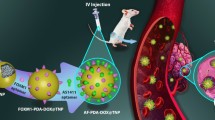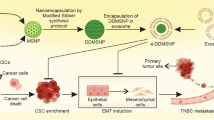Abstract
PSMA-11-HBED and PSMA-11-HYNIC are well-known prostate cancer (PCa) ligands, which strongly bind to prostate- specific membrane antigen (PSMA) on PCa epithelial cells. In this study, we announced the synthesis, physico-chemical properties and in vitro binding assay of targeted iron oxide nanoparticles (IONPs) by the PSMA-11 peptides as an MRI nanocontrast agent for early PCa discernment. IONPs were coated with carboxymethylated dextran (CMD-IONPs) and also with bovine serum albumin (BSA-IONPs), then conjugated with two different amounts of PSMA-11-HYNIC (T-CMD-IONPs) and PSMA-11-HBED (T-BSA-IONPs). In addition, the cellular viability, relaxometry measurements in aqueous and in vitro media, as well as quantitative cell uptake of the synthesized formulations were evaluated. At diagnostic concentrations, IONPs showed no cytotoxicity. A comparison of T-BSA-IONPs and T-CMD-IONPs with non-targeted IONPs at concentration \(750\,\mu M\) indicates that LNCaP PSMA + prostate cancer cells took up, respectively, 5.02 and 1.77 times as much IONPs. The results validated distinguished \({r_2(mM^{-1}s^{-1})}\) values at \(1.5\,T\) MRI scanner as 160 for CMD-IONPs and 68 for BSA-IONPs. Moreover, targeted-IONPs in-vitro had higher \({r_2}\) values than untargeted IONPs. The contrast to noise ratio (CNR) between targeted and non-targeted IONPs at concentration \(750\,\mu M\) were calculated as 4.65 and 3.95 for T-BSA-IONPs and T-CMD-IONPs, respectively. The study confirms that the novel T-BSA-IONPs and T-CMD-IONPs nanoprobes are suitable negative contrast agents for molecular imaging of PCa.






Similar content being viewed by others
References
Abd Elrahman AA, Mansour FR (2019) Targeted magnetic iron oxide nanoparticles: preparation, functionalization and biomedical application. J Drug Deliv Sci Technol 52:702
Abdolahi M, Shahbazi-Gahrouei D, Laurent S, Sermeus C, Firozian F, Allen BJ, Boutry S, Muller RN (2013) Synthesis and in vitro evaluation of MR molecular imaging probes using J591 mAb-conjugated SPIONs for specific detection of prostate cancer. Contrast Media Mol Imaging 8(2):175
Abraham C, Jani P, Turuba R, Campbell M, Zehbe I, Curiel L (2017) In vivo 3T magnetic resonance imaging using a biologically specific contrast agent for prostate cancer: a nude mouse model. J Nanotechnology 2017:1
Afshar-Oromieh A, Babich JW, Kratochwil C, Giesel FL, Eisenhut M, Kopka K, Haberkorn U (2016) The rise of PSMA ligands for diagnosis and therapy of prostate cancer. J Nuclear Med 57(Supplement 3):79S
Ahn T, Roberts MJ, Abduljabar A, Joshi A, Perera M, Rhee H, Wood S, Vela I (2019) A review of prostate-specific membrane antigen (PSMA) positron emission tomography (PET) in renal cell carcinoma (RCC). Mol Imaging Biol 21(5):799
Basha MAA, Hamed MAG, Hussein O, El-Diasty T, Abdelkhalek YI, Hussein YO, Alasamer AF, Mohamed HA, Deen DSE, Tantawy EF et al (2019) 68Ga-PSMA-11 PET/CT in newly diagnosed prostate cancer: diagnostic sensitivity and interobserver agreement. Abdom Radiol 44(7):2545
Bates D, Abraham S, Campbell M, Zehbe I, Curiel L (2014) Development and characterization of an antibody-labeled super-paramagnetic iron oxide contrast agent targeting prostate cancer cells for magnetic resonance imaging. PLoS One 9(5):e97220
Bushberg JT, Boone JM (2011) Image quality, the essential physics of medical imaging. Philadelphia, Lippincott Williams & Wilkins, p 90
Byong Y, Kwak S (2010) Assembly of magnetite nanoparticles into spherical mesoporous aggregates with a 3-D wormhole-like porous structure. J Mater Chem 20:8320
Catalona WJ, Richie JP, Ahmann FR, Hudson MA, Scardino PT, Flanigan RC, Dekernion JB, Ratliff TL, Kavoussi LR, Dalkin BL et al (1994) Comparison of digital rectal examination and serum prostate specific antigen in the early detection of prostate cancer: results of a multicenter clinical trial of 6,630 men. J Urology 151(5):1283
Deng LH, Jiang H, Lu FL, Wang HW, Pu Y, Wu CQ, Tang HJ, Xu Y, Chen TW, Zhu J et al (2021) Size and PEG length-controlled PEGylated monocrystalline superparamagnetic iron oxide nanocomposite for MRI contrast agent. Int J Nanomed 16:201
Doustkhah E, Heydarizadeh M, Fathi Z, Mohtasham H, Rostamnia S, Hasani M (2019) Dithiocarbamate modified SPION-chitosan nanobiocomposite, a promising adsorbent for bovine serum albumin (BSA). Chem Methodol 3(5):562
Frtús A, Smolková B, Uzhytchak M, Lunova M, Jirsa M, Kubinová Š, Dejneka A, Lunov O (2020) Analyzing the mechanisms of iron oxide nanoparticles interactions with cells: a road from failure to success in clinical applications. J Controll Release 328:59
Ghorbani F, Imanparast A, Hataminia F, Sazgarnia A (2018) A novel nano-superparamagnetic agent for photodynamic and photothermal therapies: an in-vitro study. Photodiagn Photodyn Ther 23:314
Ghorbani F, Seyedi S, Montazerabadi A (2021) Magnetic particle imaging and its application. Front Biomed Technol 8(2):143
Guthman DA, Bergstralh EJ, Wilson TM, Zincke H, Blute ML, Oesterling JE (1993) Biopsy proved prostate cancer in 100 consecutive men with benign digital rectal examination and elevated serum prostate-specific antigen level: Prevalence and pathologic characteristics. Urology 42(2):150
Jalali F, Dorraji PS, Mahdiuni H (2014) Binding of the neuroleptic drug, gabapentin, to bovine serum albumin: Insights from experimental and computational studies. J Luminescence 148:347
Kiess A, Banerjee S, Mease R, Rowe S, Rao A, Foss C, Chen Y, Yang X, Cho S, Nimmagadda S et al (2015) Prostate-specific membrane antigen as a target for cancer imaging and therapy. Q J Nuclear Med Mol Imaging : Off Publ Italian Assoc Nuclear Med (AIMN) Int Assoc Radiopharmacol (IAR) Sect Soc 59(3):241
Knopp T, Buzug TM (2012) How magnetic particle imaging works, magnetic particle imaging. Springer, Berlin, pp 11–70
Li TJ, Huang CC, Ruan PW, Chuang KY, Huang KJ, Shieh DB, Yeh CS (2013) In vivo anti-cancer efficacy of magnetite nanocrystal-based system using locoregional hyperthermia combined with 5-fluorouracil chemotherapy. Biomaterials 34(32):7873
Maenosono S, Suzuki T, Saita S (2008) Superparamagnetic FePt nanoparticles as excellent MRI contrast agents. J Magn Magn Mater 320(9):L79
Mikhaylova M, Kim DK, Berry CC, Zagorodni A, Toprak M, Curtis AS, Muhammed M (2004) BSA immobilization on amine-functionalized superparamagnetic iron oxide nanoparticles. Chem Mater 16(12):2344
Mohammadi Z, Attaran N, Sazgarnia A, Shaegh SAM, Montazerabadi A (2020) Superparamagnetic cobalt ferrite nanoparticles as T 2 contrast agent in MRI: in vitro study. IET Nanobiotechnol 14(5):396
Montazerabadi AR, Oghabian MA, Irajirad R, Muhammadnejad S, Ahmadvand D, Delavari HH, Mahdavi SR (2015) Development of gold-coated magnetic nanoparticles as a potential MRI contrast agent. Nano 10(04):1550048
Nagesh PK, Johnson NR, Boya VK, Chowdhury P, Othman SF, Khalilzad-Sharghi V, Hafeez BB, Ganju A, Khan S, Behrman SW et al (2016) PSMA targeted docetaxel-loaded superparamagnetic iron oxide nanoparticles for prostate cancer. Colloids Surf B: Biointerfaces 144:8
Ngen EJ, Benham Azad B, Boinapally S, Lisok A, Brummet M, Jacob D, Pomper MG, Banerjee SR (2019) MRI assessment of prostate-specific membrane antigen (PSMA) targeting by a PSMA-targeted magnetic nanoparticle: potential for image-guided therapy. Mol Pharm 16(5):2060
Nosrati H, Salehiabar M, Manjili HK, Danafar H, Davaran S (2018) Preparation of magnetic albumin nanoparticles via a simple and one-pot desolvation and co-precipitation method for medical and pharmaceutical applications. Int J Biological Macromol 108:909
Patel P, Wang S, Siddiqui MM (2019) The use of multiparametric magnetic resonance imaging (mpMRI) in the detection, evaluation, and surveillance of clinically significant prostate cancer (csPCa). Curr Urol Rep 20(10):1
Rahbar K, Afshar-Oromieh A, Jadvar H, Ahmadzadehfar H (2018) PSMA theranostics: current status and future directions. Mol Imaging 17:1536012118776068
Shevtsov MA, Nikolaev BP, Yakovleva LY, Marchenko YY, Dobrodumov AV, Mikhrina AL, Martynova MG, Bystrova OA, Yakovenko IV, Ischenko AM (2014) Superparamagnetic iron oxide nanoparticles conjugated with epidermal growth factor (SPION-EGF) for targeting brain tumors. Int J Nanomed 9:273
Sillerud LO (2016) Quantitative [Fe] MRI of PSMA-targeted SPIONs specifically discriminates among prostate tumor cell types based on their PSMA expression levels. Int J Nanomed 11:357
Silong H, Xiaoping X, Yao Z et al (2016) Preliminary clinical study of 99mTc-labelled small molecules against PSMA for prostate cancer imaging. China Oncol 26(7):608
Smith CP, Laucis A, Harmon S, Mena E, Lindenberg L, Choyke PL, Turkbey B (2019) Novel imaging in detection of metastatic prostate cancer. Curr Oncol Rep 21(4):1
Sun Y, Zhu Y, Huang C, Li R, Chen Y, Duan Y (2016) Magnetite loaded Polypeptide-PLGA multifunctional microbubbles for dual-mode US/MR imaging. Contrast Media Mol Imaging 11(2):146
Taylor RM, Huber DL, Monson TC, Ali AMS, Bisoffi M, Sillerud LO (2011) Multifunctional iron platinum stealth immunomicelles: targeted detection of human prostate cancer cells using both fluorescence and magnetic resonance imaging. J Nanopart Res 13(10):4717
Topală T, Bodoki A, Oprean L, Oprean R (2014) Bovine serum albumin interactions with metal complexes. Clujul Med 87(4):215
Yousefvand M, Mohammadi Z, Ghorbani F, Irajirad R, Abedi H, Seyedi S, Papi A, Montazerabadi A (2021) Investigation of specific targeting of triptorelin-conjugated dextran-coated magnetite nanoparticles as a targeted probe in GnRH+ cancer cells in MRI. Contrast Media Mol Imaging 2021:5534848
Yu MK, Kim D, Lee IH, So JS, Jeong YY, Jon S (2011) Image-guided prostate cancer therapy using aptamer-functionalized thermally cross-linked superparamagnetic iron oxide nanoparticles. Small 7(15):2241
Zhou Z, Zhao Z, Zhang H, Wang Z, Chen X, Wang R, Chen Z, Gao J (2014) Interplay between longitudinal and transverse contrasts in Fe3O4 nanoplates with (111) exposed surfaces. ACS Nano 8(8):7976
Acknowledgements
The data presented in this research were part of a PhD thesis which was performed at Department of Medical Physics, Mashhad University of Medical Sciences (MUMS), Mashhad, Iran. This work was supported by the Iran National Science Foundation: INSF [grant numbers 99023254]; the Student Research Committee of Mashhad University of Medical Sciences, Mashhad, Iran [grant number 991161].
Author information
Authors and Affiliations
Corresponding author
Ethics declarations
Conflict of interest
This work was partially supported by [Iran National Science Foundation] (Grant number 99023254) and [the Student Research Committee of Mashhad University of Medical Sciences, Mashhad, Iran] (Grant number 991161).
Additional information
Publisher's Note
Springer Nature remains neutral with regard to jurisdictional claims in published maps and institutional affiliations.
Iran National Science Foundation: INSF (grant number 99023254);
Student Research Committee of Mashhad University of Medical Sciences, Mashhad, Iran (grant number 991161);
Rights and permissions
About this article
Cite this article
Ghorbani, F., Irajirad, R., Emami, F. et al. Specified iron oxide nanoparticles by PSMA-11 as a promising nanomolecular imaging probe for early detection of prostate cancer. Appl Nanosci 12, 2291–2304 (2022). https://doi.org/10.1007/s13204-022-02507-5
Received:
Accepted:
Published:
Issue Date:
DOI: https://doi.org/10.1007/s13204-022-02507-5




